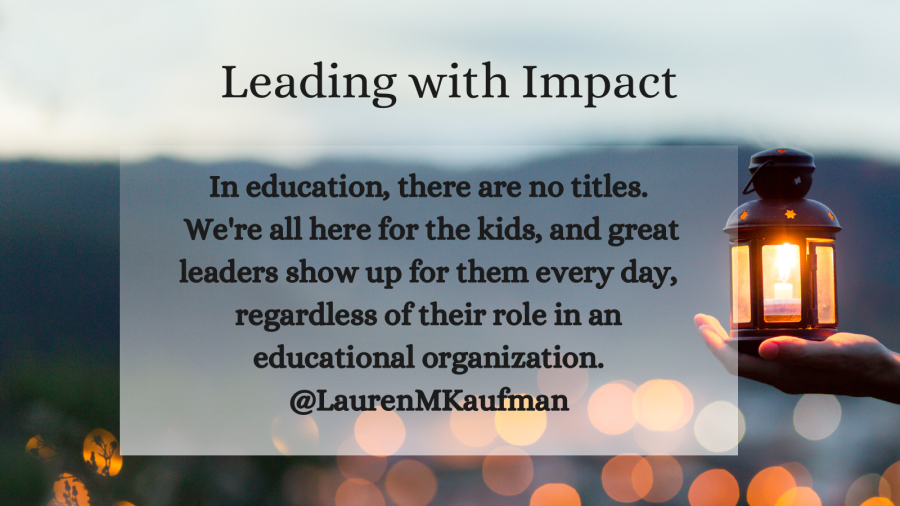“Many leaders are scared about developing people and then having them leave. They should be more worried about not developing people and having them stay.” Last year, as I scrolled through social media, my finger paused over this quote from George Couros’ post. When I’m inspired by someone else’s ideas, whether in a book, podcast, or social media post, I often jot them down in the notes section of my phone for safekeeping. It’s my go-to space for easily retrieving information when needed or connecting ideas. I read it several times, letting its significance sink in.
This week, while catching up on leadership blogs and newsletters, I found myself in a familiar scenario. It was déjà vu as I stumbled upon another of George Couros’ blogs titled, “4 Ways to Lead Up.” Once again, my finger hovered over my smartphone’s screen as I read the following: “But I am very quick to note that leadership and administration aren’t the same word. Some of the best leaders in schools are teachers, and some of the worst leaders are administrators. This is true with all professions.” This idea deeply resonated with me. In education, there are no titles. We’re all here for the kids, and great leaders show up for them every day, regardless of their role in an educational organization.
Ironically, in this blog, George was reflecting on his past learning and connecting his ideas with the present. That’s what great educators do. They bridge the past with the present to make the future better for themselves and others.
What Resonated?
The ideas shared by George Couros deeply resonate with me, prompting reflection on my own educational journey. Could it be because of my decision to leave my home school district, where I spent the bulk of my career, to embark on a new path as a school leader? Or perhaps it’s the varied roles I’ve held throughout my journey, and the educators who have inspired me to take risks, share my learning, and advocate for personal and professional growth.
In my upcoming book, I ponder these questions as I continuously consider the qualities of exceptional leaders. Is it a great leader’s ability to communicate a clear vision and involve all stakeholders in its development? Perhaps it is their inclusive decision-making process, ensuring everyone has a voice in shaping the direction of the school system. These reflections are lanterns that guide me to recognize the importance of fostering relationships within the school community, making everyone feel seen, valued, and included.
Furthermore, I find myself drawn to leaders who lead with impact, possess a strong instructional lens, and demonstrate credibility as instructional leaders who understand teaching and learning at a profound level. It’s their humility, demonstrated by their focus on people rather than titles, and their commitment to building capacity within the organization that leaves a lasting impression.
In essence, it’s the combination of these attributes that has influenced the leaps of faith I’ve taken throughout my career, guiding me toward new opportunities and growth. I recognize that spending most of my career so far as a teacher has shaped my leadership journey, and without leaders who allowed me to lead in those positions, I wouldn’t be the leader I am still becoming today.
Inside the Classroom
This week, I had the incredible opportunity to visit several classrooms, each offering unique insights and experiences. Yet, one particular classroom left an indelible impression on me. As I sat among the students, I witnessed something extraordinary—a leader emerging within a novice teacher. The way she commanded the room, with a perfect blend of authority and empathy, was truly inspiring. Her students hung on her every word, listening attentively and engaging in thoughtful discussions with one another.
What struck me most was the clarity and consistency with which she communicated the class expectations. It was evident that her students held her in high regard, not just as a teacher, but as a leader they respected and admired. Watching her seamlessly adapt and pivot in real-time underscored the essence of responsive teaching at its finest.
In that moment, I couldn’t help but reminisce about my own journey and the pivotal role my first principal played. I vividly recalled her words of encouragement, affirming my leadership potential. Drawing from that experience, I approached the teacher and echoed those sentiments. “Ms. P., you are a leader,” I said. “You will continue to show up every day like one. Your impact will extend far beyond the classroom, and I have no doubt that you will thrive in whatever future roles you pursue. I’ll be here, cheering you on every step of the way.”
Moving Forward
In the book Lead From Where You Are: Building Intention, Connection, and Direction in Our School, Dr. Joe Sanfelippo shares, “Finding those who push your thinking and support you in the journey is key to moving forward–and transforming your school community into a group of potential leaders.”
Let’s be the leaders who develop people and then encourage them to expand their influence. Let’s continue to shape leaders at all levels. Let’s be the leaders who see something special in someone else. You have the ability to change the trajectory of the lives of others. Lead with impact. That’s what great educators do. They bridge the past with the present to make the future better for themselves and others.
Actionable Ideas to Implement Tomorrow
Here are some more of my observations about Leaders Who Develop Leaders at all levels of an organization:
They…
- Optimize, not criticize
- Give recognition
- Show sincere appreciation
- Value other perspectives
- Show humility, vulnerability, and talk about their own mistakes
- Ask questions and make suggestions
- Celebrate big and small wins
- Give honest feedback
